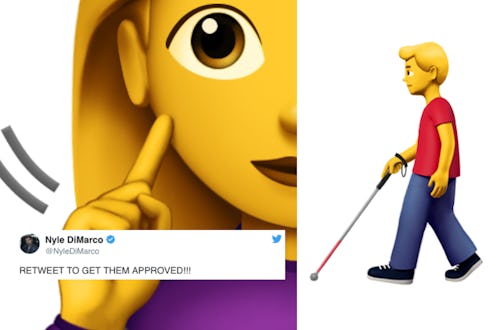Life
Emojis Representing Disability Could Be Coming To Your iPhone
Smartphone users may see their emoji libraries becoming a little more inclusive in the coming months, thanks to Apple's latest proposed additions. The tech giant has officially submitted a proposal to expand its suite of emojis by adding 13 new accessibility-related emojis, including emojis of service dogs, different types of wheelchairs, and the sign for "Deaf" in American Sign Language. Apple worked with leading organizations for disabled people to develop the emojis, and hopes to add the emojis because current ones "provide a wide range of options, but may not represent the experiences of those with disabilities," Apple said in its proposal to the Unicode Consortium, which must approved the new emojis before they can be added to iOS and other operating systems.
"At Apple, we believe that technology should be accessible to everyone and should provide an experience that serves individual needs," Apple said in its proposal. "Adding emoji emblematic to users’ life experiences helps foster a diverse culture that is inclusive of disability."
According to Apple's proposal, "the current selection of emoji provides a wide array of representations of people, activities, and objects meaningful to the general public, but very few speak to the life experiences of those with disabilities." Its new set of proposed emojis are intended to help represent people who have "physical [disabilities] involving vision, hearing, or loss of physical motor skills, or [...] more hidden, invisible [disabilities]."
Apple worked with organizations including the Cerebral Palsy Foundation, the American Council of the Blind, and the National Association of the Deaf to create a set of emojis in four main disability categories: Blind and Low Vision, Deaf and Hard of Hearing, Physical Motor, and Hidden Disabilities, according to the proposal. "[W]e believe this proposal is a significant step forward in representing more diverse individuals, and we hope it will spark a global dialogue around better representation for people with disabilities," Apple said in the proposal.
These 13 emojis are hugely important, but Apple knows they will not represent everyone's disabilities, the company said in its proposal. "Every individual's experience with their disability is unique and, therefore, the representations have unlimited possibilities," the company said in its proposal. "It would be impossible to cover every possible use case with a limited set of characters. For this proposal, we have selected a set of emoji that are most inclusive to a large number of people."
Apple hopes this set will "serve as a starting point for greater diversity within emoji," it said in the proposal.
Apple has been diversifying its emoji collection for years. Back in 2014, Katie Cotton, Apple's vice president of worldwide corporate communications, told MTV, "There needs to be more diversity in the emoji character set, and we have been working closely with the Unicode Consortium in an effort to update the standard," Vox reported.
Inclusive emoji efforts have included adding emojis for LGBTQ couples, adding several expansions to represent more skin tones, and in 2016, adding more gender diversity by creating more emojis for women athletes and professionals, as well as adding single-parent family options.
Real talk: As someone who has multiple invisible disabilities, it is so refreshing to see a brand as large as Apple making deliberately inclusive moves for people like me, and doing so by working with organizations that support disabled folks. While these emojis obviously do not include representation for people with disabilities like chronic pain, mental disabilities, or mental illnesses, this set still goes a long way toward embracing people who are too often excluded, and I for one can't wait to see them pop up in my emoji library.
Editor's note: This piece was updated from its original version on March 26, 2018.
